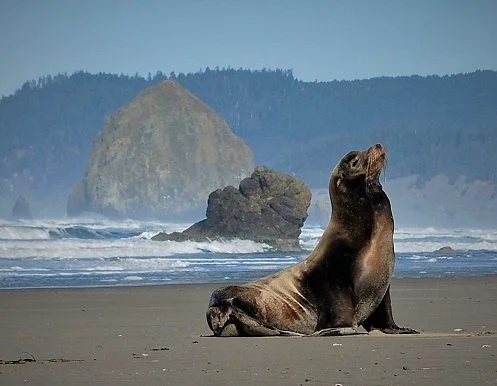California Sea Lion (Zalophus californianus)
Sea lion in front of Haystack Rock (photo credit: HRAP Archives)
California sea lion (photo credit: USFWS)
Adult male sea lion with two females and a pup (photo credit: USFWS)
Description: California sea lions are the most common sea lions, or “eared seals”, in Oregon. They grow to be around 2 m long with males being about 0.5 m bigger and they weigh between 110 (females) and 320 (males) kg. Both males and females are tan or brown with long pectoral flippers and small ear flaps. Unlike true seals, sea lions walk using their pectoral and hind flippers like legs. California sea lions are known for their intelligence and, in Oregon, have a reputation for hunting in strategic locations like near fisherman or at the bottom of fish ladders. When they are hauled out on a beach or dock, you can often hear their distinctive barks.
Habitat: Although California sea lions range from southeast Alaska/northern British Columbia to central Mexico, it is rare to see females in Oregon. California sea lions breed in the Channel Islands of California and in Baja California, Mexico. During non-breeding season, males travel north to feed, but females and their pups typically stay close to their breeding grounds. In Oregon, male California sea lions are found on secluded beaches, offshore island, or large estuaries like the mouth of the Columbia River. The best places to see California seal lions on the northern Oregon Coast are on the docks in Astoria or from Tillamook Head - with the assistance of binoculars, you can see them surrounding Tillamook Head Lighthouse.
Diet: California sea lions hunt many species of fish including rockfish, sardines, anchovies, salmon, dogfish sharks, as well as squid and clams.
Tide Pool Tidbits:
California sea lion pups nurse for more than a year. During this time, the mothers often leave the pups onshore for days at a time while she hunts for food.
The lifespan of a California sea lion is 20 to 30 years.
California sea lions are very social animals and spend both breeding and non-breeding season in large groups. The largest breeding rookery is on San Miguel Island, California and has around 80,000 sea lions.




